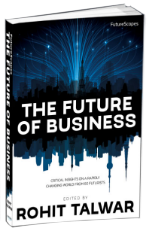10 Aug Your child in year 2100. Forecasts from the world’s leading futurists.
 For a child born today, what will the world look like in 2100? This is the topic of a special section of The Futurist, September- October issue. Via scenarios and forecasts from some of the leading expert within foresight, we get a glimpse into what it will mean to be 88 at the dawn of the next century. This is the future of the Homeland generation. Millennials will be 96 to 120 if they are alive and some of them will. Some scenarios make me infer that some Generation X members are still with us as “post-centenarians”. Others take the the transhumanist/singulitarian view that we have passed the point where we will be able to live forever.
For a child born today, what will the world look like in 2100? This is the topic of a special section of The Futurist, September- October issue. Via scenarios and forecasts from some of the leading expert within foresight, we get a glimpse into what it will mean to be 88 at the dawn of the next century. This is the future of the Homeland generation. Millennials will be 96 to 120 if they are alive and some of them will. Some scenarios make me infer that some Generation X members are still with us as “post-centenarians”. Others take the the transhumanist/singulitarian view that we have passed the point where we will be able to live forever.
The trends and emerging issues covered range from energy, climate changes, economic systems, space travel, scientific breakthroughs – particularly in biology and computing – and of course, aging.
Extreme longevity seems to show up in many of the narratives, reflecting long anticipated breakthroughs in medicine, computing and biotechnology. Resource depletion combined with resource scarcity, governmental issues and dwelling patterns are other issues.
The “mood” of these forecasts, or the level of pessimism vs. optimism, seems to be in line with most futurist projections: If and when we can manage to reform ourselves before we totally ruin the planet, it’s going to worse only until it gets better. Similar to cycle theories like the Kondratiev long waves or Strauss and Howe’s generational predictions, we will most likely go through a period of crisis – a period we have already entered – before we enter a new “high period”.
Dr. William Halal and Laura B Huhn from TechCast believe a new high tech era will occur around 2020. This view is similar to that of Olli Hietanen and Marko Ahvenainen, Finland Futures Research Centre, who forecast a Sixth Kondratieff wave (2010 – 2050) based on new innovation and technologies within biotechnology. The Sixth wave differs from the Fifth because of the increasingly rising prices on raw materials and energy. The new paradigm in innovation and production is likely to be within molecular, or synthetic, biology, which will allow us to grow and change structures from raw biological materials. Just think about all the experiments happening with stem cells and organ scaffolding in the labs today! Not to mention biological 3-D printing. Tissue engineering will enable us to grow new organs and artificial meats, even biodegradable polymers to be used in manufacturing. These prospects might be frightening to some, conjuring up 19th and 20th century sci-fi dystopias like Frankenstein and Brave New World. But for most futurists, the unsustainable alternative of status quo is often much scarier!
Since the theme revolves around the future perspective of a child born today, the topic of aging recurs frequently in the scenarios and forecasts. By today’s standard 88 is a fairly old age and we don’t consider there to be much life changes after this age. But at the beginning of the next century the age of 88 might only bring an occasional midlife crisis. Such life expectancy is what VP of Rehab and Wellness at Encore Healthcare, Marta Keane project for the child whose newborn picture is uploaded to Facebook just at this moment. Due to aforementioned progress in regenerative medicine, biological deterioration in old age can be overcome. And through access to ubiquitous customized treatment and diagnosis systems via the outfittings of their future “smart homes”, patients can monitor much of their own health at home. This scenario helps overcome the anticipated shortcomings of physician availabilities many places. See my When will we consult our phones before the doctor? from last year. Since people live longer, family and marriage life will also change over a person’s life span. “Till death do us apart” may become “Till we decide to move on”.
Jouni J. Sakijarvi sums this future up with the descriptive title Paradise Found: No Aging, No Pensions. This actually makes me realize: none of these futurists have mentioned the immediate demographic challenges facing industrial countries in the very near future. None of the scenarios go to depths at explaining exactly when and how we enter this bright new future. When do we go from an elder boom, which by conventional expectations will depend largely on the current unsustainable system, to the high-tech augmented, synthesized, and biomanipulated future where health and independence triumph over traditional health limitations? How do we implement new technologies, systems etc. in our old social structures?
There are many commonalities in these forecasts, revealing that futurists tend to think alike. But in some areas I see diverging predictions. One relates to the transhumanist idea that homo sapiens will eventually reach a point where they can live forever. Other are less radical. But despite disagrements whether or not there is a hard-wired limit in the human organism most believe lifespan will continue to increase.
Energy seems to be area portraying most divergent futures – and perhaps indicating a divergence among futurists? Berkley professor Ozzie Zehner embeds his forecasts in a sober, more traditional epistemology, mentioning mostly already known technologies and incremental steps towards energy prosperity with various set backs along the say. Other scenarios paint more rosy pictures where we capture most of our energy needs from sun, fusion and various restructuring at the cellular/nano level.
 All in all these scenarios and forecasts are inspiring reading and provide some hope that if humanity can get through some initial bottlenecks, a pretty good life is waiting for us on the other side of the climatic and economic squeeze that threaten our world systems at the moment. It’s all about priorities, and if we really do want to create a better future for our children, the blue print for how to do it is already here.
All in all these scenarios and forecasts are inspiring reading and provide some hope that if humanity can get through some initial bottlenecks, a pretty good life is waiting for us on the other side of the climatic and economic squeeze that threaten our world systems at the moment. It’s all about priorities, and if we really do want to create a better future for our children, the blue print for how to do it is already here.
Images: Stuart Miles, freedigitalphotos.net, Vegetable Girl by Vera Kratochvil
Decompose by zaldy icaonapo


Sorry, the comment form is closed at this time.